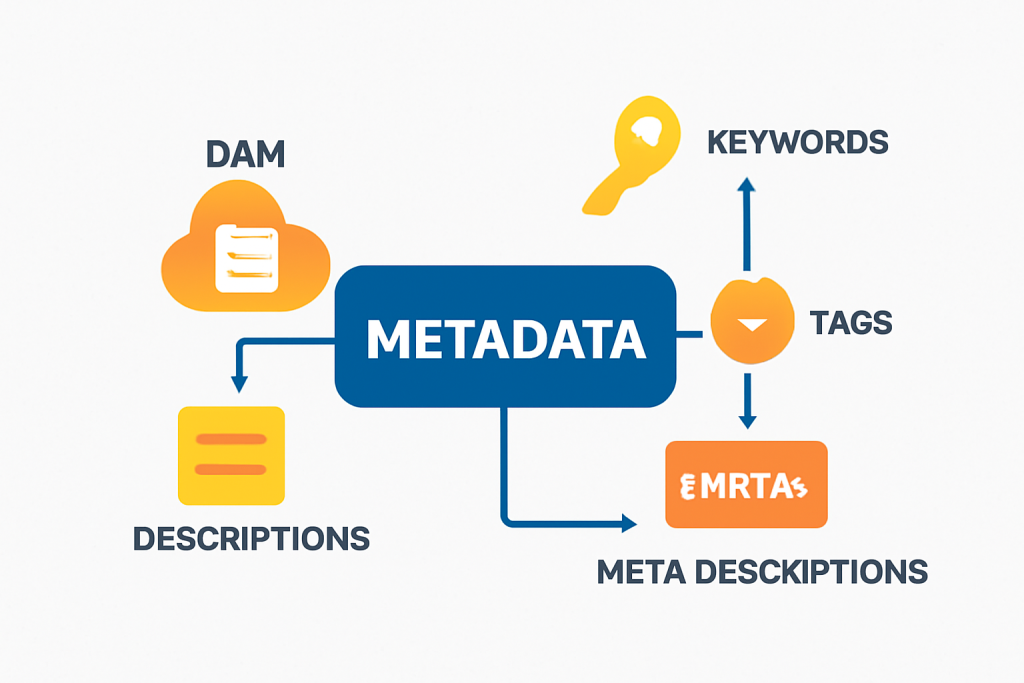
In the fast-paced digital landscape, ensuring your content is organized, discoverable, and optimized is essential for success. Whether you’re an SEO professional, digital marketer, or part of a content team, understanding the role of metadata is fundamental to achieving both SEO and Digital Asset Management (DAM) success. Metadata influences how search engines index your content, how your team accesses digital assets, and how effectively you can manage your content across different platforms. In this blog, we will dive into why metadata is a cornerstone of both SEO and DAM success, and how platforms like Wizbrand can help you harness the power of metadata to streamline workflows and optimize your digital content.
What Is Metadata?
In simple terms, metadata is data that provides detailed information about other data. It includes elements such as titles, descriptions, keywords, tags, creation dates, and more, which help categorize, describe, and index digital assets such as images, videos, and web pages. While metadata is often invisible to end users, it plays a significant role in the backend, enabling content to be easily located, retrieved, and understood by both humans and machines.
In the world of SEO, metadata is used by search engines to interpret and rank content based on relevance to search queries. In DAM, metadata ensures that digital assets are organized, searchable, and easy to manage across teams. Without proper metadata, both SEO performance and DAM processes can become disorganized and inefficient.
How Metadata Impacts SEO
Metadata serves as the foundation for SEO success, directly influencing how search engines rank and index content. Here’s a breakdown of how metadata impacts SEO:
1. Improved Indexing and Visibility
Search engines rely on metadata—like page titles, descriptions, and header tags—to understand the content of a page. Optimizing these elements ensures that search engines can properly index your content, making it easier for users to find. Accurate metadata also helps search engines determine how relevant your content is to user queries.
2. Enhanced User Engagement
When users search for content, they often see meta descriptions and titles before clicking on a link. Well-crafted and relevant metadata improves the chances of attracting clicks, driving higher traffic to your site. By using clear and concise meta descriptions, you enhance user experience and encourage engagement, which indirectly contributes to higher rankings.
3. Keyword Optimization
Integrating keywords into metadata—such as in the title, meta description, and alt text for images—helps search engines match your content with user queries. Proper keyword optimization in metadata ensures your content ranks for the right keywords, leading to more visibility and clicks from search engines.
4. Rich Snippets and Enhanced Listings
Proper metadata can help your content appear as rich snippets in search engine results. Rich snippets—such as review stars, pricing, or event times—make your content stand out, increasing the likelihood that users will click through. Well-optimized metadata enables search engines to display enhanced results, improving both SEO and user experience.
The Role of Metadata in Digital Asset Management

Digital Asset Management (DAM) systems rely on metadata to keep content organized and easily accessible across teams. In the world of DAM, metadata enables organizations to maintain a centralized, structured content library that is easily searchable and manageable. Here’s how metadata helps DAM systems function efficiently:
1. Efficient Search and Retrieval
With detailed metadata tags, assets can be quickly retrieved based on specific attributes such as keywords, file types, or categories. This ability to search and retrieve assets easily saves valuable time and resources, reducing the risk of misplacing or losing important files.
2. Version Control and File Management
Metadata allows DAM systems to track the version history of digital assets, ensuring that teams are always using the latest versions. By providing information on the asset’s lifecycle, metadata reduces the risk of outdated content being used, ensuring that only the most current version is accessed.
3. Access Control and Licensing
Metadata is essential for managing access rights and licensing agreements. It helps track usage permissions, ensuring that digital assets are used within the guidelines set by the organization or licensing agreements. This functionality ensures compliance and reduces the risk of legal issues related to content usage.
4. Collaboration and Consistency
Standardized metadata across all digital assets ensures that teams—whether in marketing, design, or legal—can easily access, collaborate, and reuse content. This consistency fosters smooth collaboration, ensuring that everyone is working with the correct assets, in the right formats, and adhering to brand guidelines.
Without metadata, digital assets can quickly become unorganized, leading to inefficiencies, errors, and wasted resources. A robust metadata strategy in DAM platforms ensures that content is always well-organized, accessible, and ready for use.
Why Wizbrand Is the Leading Metadata-Driven DAM Solution
When it comes to managing metadata for SEO and DAM, Wizbrand is a standout solution. As one of the Best Digital Asset Management Software, Wizbrand provides advanced metadata management features that help organizations streamline workflows and improve both SEO and content management processes.
Here’s how Wizbrand leverages metadata to enhance SEO and DAM performance:
1. Seamless Metadata Integration
Wizbrand integrates metadata directly into its DAM system, automating the process of capturing and organizing metadata for all digital assets. This reduces the need for manual tagging and ensures that content is always properly indexed, making it easy for teams to access and work with assets.
2. Centralized Metadata for Collaboration
With Wizbrand, teams across departments—such as marketing, design, and legal—can work with the same set of metadata standards. This centralized system ensures consistency and reduces errors, promoting effective collaboration between teams and improving overall productivity.
3. Scalability and Customization
Wizbrand’s flexible metadata schema can scale with your organization’s needs. Whether you’re managing hundreds or thousands of digital assets, Wizbrand adapts to accommodate growing content libraries while maintaining consistent organization and ease of use.
4. SEO-Optimized Digital Asset Management

Wizbrand is not only a DAM solution but also integrates SEO Management Software to optimize metadata for search engines. This integration ensures that your digital assets are not only well-organized but also optimized for SEO, helping improve your search engine rankings and visibility.
Conclusion
Metadata is a critical element in both SEO and Digital Asset Management. It helps search engines index and rank content while ensuring digital assets are easily searchable and well-organized. Properly implemented metadata drives higher SEO rankings, improves content accessibility, and enhances collaboration within teams.
Explore how Wizbrand can help streamline your metadata management and improve your digital asset workflows. With its advanced features and robust SEO capabilities, Wizbrand is one of the Best DAM Tools in the world and a vital partner in optimizing both SEO and content management processes. Start optimizing your digital assets today with Wizbrand!



